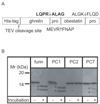Production of bioactive peptides in an in vitro system
- PMID: 17540328
- PMCID: PMC2128726
- DOI: 10.1016/j.ab.2007.04.020
Production of bioactive peptides in an in vitro system
Abstract
An in vitro system for the preparation of bioactive peptides is described. This system couples three different posttranslational modification enzymes, prohormone convertases (PCs), carboxypeptidase E, and peptidyl alpha-amidating enzyme, to transform recombinant precursors into bioactive peptides. Three different precursors, mouse proopiomelanocortin (mPOMC), rat proenkephalin (rPE), and human proghrelin, were used as model systems. The conversion of mPOMC and rPE to smaller peptide products was measured by radioimmunoassay. After optimization of the system, excellent efficiency was obtained: about 85% of starting mPOMC was converted to des-acetyl alpha-melanocyte-stimulating hormone (alpha-MSH). For proenkephalin, 75 and 96% yields were obtained for the opioid peptides Met-RGL and Met-enk, respectively. Cell-based assays demonstrated that in-vitro-generated des-acetyl alpha-MSH successfully activated the melanocortin 4 receptor. Proghrelin digestion was used to screen the specificity of PC cleavage and to confirm the cleavage site by mass spectroscopy. Mature ghrelin was produced by human furin, mouse prohormone convertase 1, and human prohormone convertase 7 but not by mouse prohormone convertase 2. These results demonstrate that our in vitro system (1) can produce peptides in quantities sufficient to carry out functional analyses, (2) can be used to determine the specificity of proprotein convertases on recombinant precursors, and (3) has the potential to identify novel peptide functions on both known and orphan G-protein-coupled receptors.
Figures





References
-
- Rouille Y, Duguay SJ, Lund K, Furuta M, Gong Q, Lipkind G, Oliva AAJ, Chan SJ, Steiner DF. Proteolytic processing mechanisms in the biosynthesis of neuroendocrine peptides: the subtilisin-like proprotein convertases. Front. Neuroendocrinol. 1995;16:322–361. - PubMed
-
- Steiner DF. The proprotein convertases. Curr. Opin. Chem. Biol. 1998;2:31–39. - PubMed
-
- Fricker LD. Peptidases and Neuropeptide Processing. Academic Press; San Diego: 1995. Methods for studying carboxypeptidase E; pp. 237–250.
-
- Fricker LD. Carboxypeptidase E. Annu. Rev. Physiol. 1988;50:309–321. - PubMed
-
- Farzan M, Vasilieva N, Schnitzler CE, Chung S, Robinson J, Gerard NP, Gerard C, Choe H, Sodroski J. A tyrosine-sulfated peptide based on the N terminus of CCR5 interacts with a CD4-enhanced epitope of the HIV-1 gp120 envelope glycoprotein and inhibits HIV-1 entry. J. Biol. Chem. 2000;275:33516–33521. - PubMed
Publication types
MeSH terms
Substances
Grants and funding
LinkOut - more resources
Full Text Sources
Research Materials
Miscellaneous

